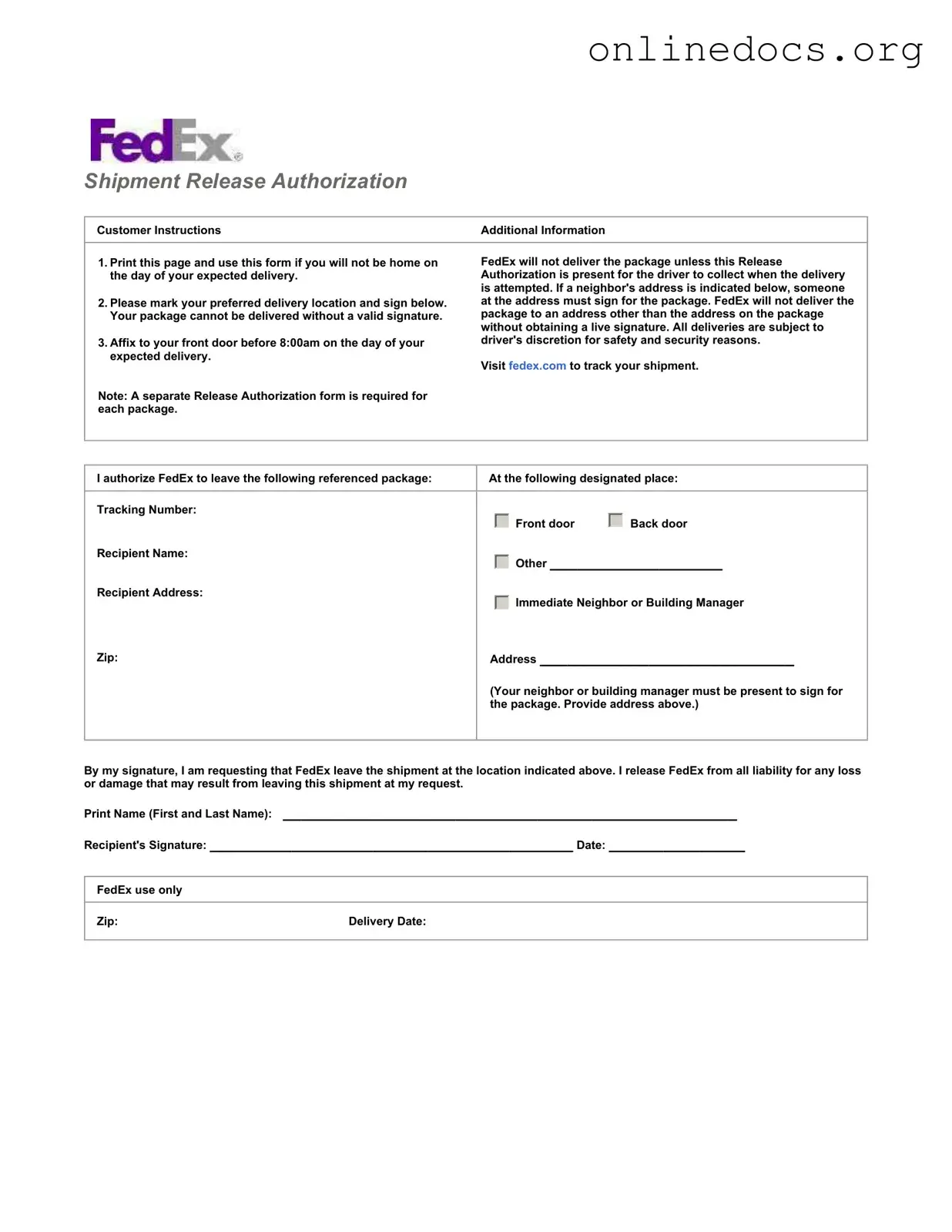The FedEx Release form shares similarities with a UPS Delivery Authorization form. Both documents allow customers to authorize a delivery service to leave packages at a specified location when the recipient is not home. This ensures that packages are delivered securely, while also providing the option for customers to specify where they would like their packages left. Like the FedEx form, the UPS form requires a signature to confirm the recipient's agreement and protects the delivery service from liability in case of loss or damage.
Another document akin to the FedEx Release form is the USPS Hold Mail Authorization form. This form permits customers to request that their mail be held at the post office for a specified period when they are away. Similar to the FedEx form, it requires the customer’s signature and ensures that the postal service has clear instructions on how to handle the mail during the absence of the recipient. Both forms provide peace of mind, knowing that packages or mail will be managed according to the recipient's wishes.
Understanding the nuances of the comprehensive Vehicle Release of Liability form can be essential for anyone involved in vehicle transactions. This document serves as a crucial safeguard for sellers, ensuring that once ownership is transferred, any potential liabilities that may arise from the vehicle's use are clearly delineated. It's important for both the seller and buyer to be aware of their responsibilities, as this helps mitigate risks associated with vehicle ownership transfer.
The Amazon Package Release form is also comparable to the FedEx Release form. This document allows customers to authorize Amazon to leave packages at designated locations when they are not available to receive them. Like the FedEx form, it requires a signature and can specify alternate drop-off locations. This helps ensure that packages are delivered safely, while also offering flexibility for customers who may not be home at the time of delivery.
A similar document is the DHL Delivery Authorization form. This form serves the same purpose as the FedEx Release form, allowing customers to authorize DHL to leave packages at a specified location. It includes a section for the recipient’s signature and outlines the conditions under which the package can be left, ensuring both parties are clear on the delivery instructions. This document also protects the delivery service from liability, echoing the intent of the FedEx form.
The Signature Release form used by local courier services is another document that parallels the FedEx Release form. This form allows customers to give permission for their packages to be left in a designated spot without a direct handoff. It typically requires the recipient's signature to confirm that they accept the terms of the release. Just like the FedEx form, it aims to facilitate smooth deliveries while providing a layer of protection for the courier service against potential claims.
The Rental Property Package Release form is similar in function as well. Often used by apartment complexes, this form allows residents to authorize staff to accept packages on their behalf when they are not available. The document usually requires a signature and outlines where packages can be left, similar to the FedEx form. This arrangement provides convenience for residents while also ensuring that the property management is protected from liability regarding lost or damaged items.
The Package Delivery Waiver form is another document that serves a similar purpose. This form allows individuals to waive the need for a signature upon delivery, permitting the courier to leave the package at a specified location. Like the FedEx Release form, it requires the recipient's agreement and signature, ensuring that the delivery service is not held responsible for any issues that may arise from leaving the package unattended.
The School Package Release form is also comparable. This document is used by parents to authorize school staff to accept and sign for packages on behalf of their children. It requires a signature from the parent or guardian, similar to the FedEx Release form, ensuring that the school has permission to receive the delivery. This helps streamline the process for parents who may not be available during school hours.
Another related document is the Business Package Release Authorization form. This form allows employees to authorize a courier to leave packages at their workplace when they are unavailable to receive them. It requires a signature and often includes specific instructions for delivery, much like the FedEx Release form. This ensures that businesses can continue to receive important shipments without interruption.
Lastly, the Insurance Claim Release form has some similarities. While primarily used for claims, this document allows individuals to authorize an insurance company to process a claim on their behalf. It requires a signature and outlines the terms of the release, similar to how the FedEx Release form outlines the terms under which a package can be left. Both forms protect the entity from liability while ensuring that the individual's wishes are respected.
